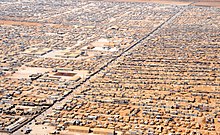Our website is made possible by displaying online advertisements to our visitors.
Please consider supporting us by disabling your ad blocker.
Syrian refugee camps
| |||
|---|---|---|---|
| Pre-war population 22 ±.5; Internally displaced 6 ±.5, Refugees 5.5 ±.5, Fatalities 0.5 ±.1 (millions)[citation needed] | |||
| Syrian refugees | |||
| By country | Turkey, Lebanon, Egypt, Jordan | ||
| Settlements | Camps: Jordan | ||
| Internally displaced Syrians | |||
| Casualties of the war | |||
| Crimes | War crimes, massacres, rape | ||
| Return of refugees, Refugees as weapons, Prosecution of war criminals | |||

Syrian refugee camp and shelters are temporary settlements built to receive internally displaced people and refugees of the Syrian Civil War. Of the estimated 7 million persons displaced within Syria, only a small minority live in camps or collective shelters. Similarly, of the 8 million refugees, only about 10 percent live in refugee camps, with the vast majority living in both urban and rural areas of neighboring countries.[1][2] Beside Syrians, they include Iraqis, Palestinians, Kurds, Yazidis, individuals from Somalia, and a minority of those who fled the Yemeni and Sudanese civil wars.[3][4]
There were 2 million school-aged refugee children (aged 5–17 years) among the 5 million refugees registered in Turkey, Lebanon, Jordan, Iraq and Egypt by the end of 2016. 1.1 million of those children have had access to either formal education (900,000) or non-formal education (150,000), including over 6,600 Palestine refugee children from Syria.[5] Humanitarian aid during the Syrian Civil War focuses on basic needs, health care, education and providing jobs. Most of the burden remains on the host countries, which face a stressed economy and export disruption, with the additional population, mostly outside of camps, causing significant pressure on public and private (e.g. housing) infrastructure.[2]
- ^ "Syria Regional Refugee Response". Refugees Operational Portal. UNHCR. 2017. Archived from the original on 19 February 2018. Retrieved 1 May 2017.
- ^ a b The Regional Refugee and Resilience Plan (3RP) (2017). Regional Strategic Overview 2016–2017 (PDF) (Report). p. 6. Retrieved 1 May 2017.
{{cite report}}: CS1 maint: numeric names: authors list (link) - ^ "ECHO Factsheet – Jordan: Syria Crisis" (PDF). ECHO. January 2017. Retrieved 1 May 2017.
- ^ "ECHO Factsheet – Turkey: Refugee crisis" (PDF). ECHO. January 2017. Retrieved 1 May 2017.
- ^ The Regional Refugee and Resilience Plan (3RP) (2017). 2016 Annual Report (PDF) (Report). p. 17. Retrieved 1 May 2017.
{{cite report}}: CS1 maint: numeric names: authors list (link)
Previous Page Next Page


